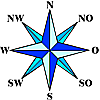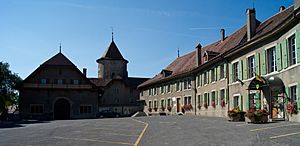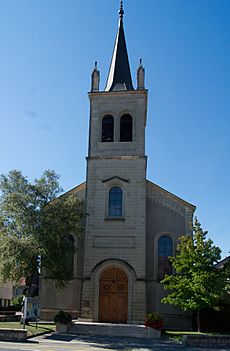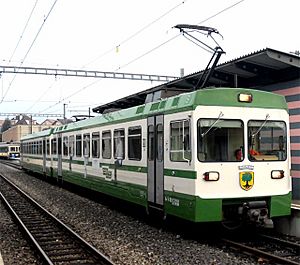Échallens facts for kids
Quick facts for kids
Échallens
|
||
|---|---|---|
 |
||
|
||
| Country | Switzerland | |
| Canton | Vaud | |
| District | Gros-de-Vaud | |
| Area | ||
| • Total | 6.66 km2 (2.57 sq mi) | |
| Elevation | 617 m (2,024 ft) | |
| Population
(Dec 2020 )
|
||
| • Total | 5,729 | |
| • Density | 860.2/km2 (2,227.9/sq mi) | |
| Postal code |
1040
|
|
| Surrounded by | Villars-le-Terroir, Poliez-le-Grand, Bottens, Malapalud, Assens, Saint-Barthélemy, Goumoens-la-Ville. | |
Échallens is a town in Switzerland. It's located in the Vaud canton, specifically in the Gros-de-Vaud area. Échallens is known as a municipality, which is like a local government area.
Contents
History of Échallens
The area where Échallens is located has been settled for a very long time. People lived here even in the Bronze Age, as shown by old foundry remains.
Early Names and Rulers
The first time Échallens was written about was in 1141. Back then, it was called Charlens. Over time, its name changed to Challeins, Escharlens, and Eschallens. The name Échallens, as we know it today, first appeared in 1315. It comes from the personal name Charles.
Originally, the land belonged to the Bishop of Lausanne. In the late 1100s, powerful lords from Burgundy built a castle here. By 1317, the House of Savoy also had rights over the area.
Becoming a City
In 1350, Échallens got walls built around it. The next year, in 1351, it was given "city rights." This meant it could hold a weekly market, which it did for many years.
In 1410, the town came under the rule of the House of Chalon. After the Burgundian Wars, in 1476, Échallens was taken over by the Swiss states of Fribourg and Bern. They managed the town together.
Religion and Modern Times
Because both Catholic Fribourg and Protestant Bern ruled Échallens, the town remained Catholic. The Protestant Reformation did not change its religion.
From 1798 to 1803, Échallens was part of the canton of Léman. Then, Napoleon helped make it part of the Vaud canton. Since 1798, Échallens has been the main town of its district.
Geography of Échallens
Échallens covers about 6.66 square kilometers (2.57 square miles). A large part of this land, about 63.8%, is used for farming. Forests cover about 13.1% of the area.
Land Use and Features
About 22.2% of Échallens is covered by buildings and roads. A small part, less than 1%, is rivers or lakes. The rest is land that isn't used for farming or building.
Most of the built-up area is homes and other buildings. Roads and industrial buildings also take up some space. The forests are mostly dense trees. For farming, people grow crops, have pastures for animals, and grow fruits or grapes.
Location and Surroundings
Échallens is located about 14 kilometers (8.7 miles) north of Lausanne. It sits on a high flat area called the Gros de Vaud plateau. This area is known as the "breadbasket" of the Vaud canton because of its fertile land.
The Talent river flows through Échallens from east to west. The highest point in the town is 672 meters (2,205 feet) high, located in the municipality's woods. Échallens is surrounded by other towns like Villars-le-Terroir, Poliez-le-Grand, and Assens.
| Goumoens-la-Ville | Villars-le-Terroir | Villars-le-Terroir |
| Saint-Barthélemy |  |
Poliez-le-Grand |
| Assens | Malapalud | Bottens |
Coat of Arms
The coat of arms for Échallens shows a black oak tree with green leaves and brown acorns on a gold background. The tree's roots are also visible.
Population and People
Échallens has a population of about 5,518 people as of 2023. Over the last ten years, the population has grown by about 25.7%. This growth is mostly due to people moving into the town.
Languages Spoken
Most people in Échallens speak French, about 89.1% of the population. German is the second most common language, spoken by about 2.8% of residents. Portuguese is third, spoken by 2.1%.
Where People Come From
About 20.9% of the people living in Échallens were also born there. Many others, about 43.9%, were born in the same canton (Vaud). About 14.4% were born elsewhere in Switzerland, and 18.7% were born outside of Switzerland.
Age Groups
In Échallens, about 12.6% of the population are children aged 0-9. Teenagers aged 10-19 make up about 14.8%. Adults aged 20-59 make up a large part of the population. Older adults, aged 60 and above, make up about 16.3%.
Homes and Households
There are about 1,634 private homes in Échallens, with an average of 2.6 people living in each. About 27% of homes have only one person living in them. Many homes are married couples with or without children.
The historical population of Échallens has grown over the centuries:

Economy and Jobs
Échallens is an important business hub for the Gros de Vaud region. For a long time, farming was the main activity. Today, farming is a very small part of the economy.
Main Industries
Over time, Échallens slowly developed industries. These included making machines, working with metal, and producing textiles (fabrics).
Most jobs in Échallens today are in the service sector. This means jobs like retail, healthcare, and education. Many people who live in Échallens also travel to Lausanne for work.
Workforce and Commuting
In 2010, the unemployment rate in Échallens was 4.3%. Most people work in the service sector, which has about 213 businesses. The manufacturing and construction sectors also provide many jobs.
Many people who live in Échallens travel to other towns for work. At the same time, many people come into Échallens to work. About 15.6% of workers use public transport, while 63% use a private car.
Religion in Échallens
Based on a 2000 survey, about 38.9% of people in Échallens are Roman Catholic. About 37.3% belong to the Swiss Reformed Church (a Protestant church).
Other Christian churches, including Orthodox churches, make up about 4.18% of the population. There are also people who follow Islam (1.89%) and other religions. About 10.84% of the population do not belong to any church.
Weather in Échallens
Échallens usually has about 121.6 days of rain or snow each year. On average, it gets about 972 millimeters (38.3 inches) of rain or snow.
The wettest month is June, with about 99 millimeters (3.9 inches) of rain or snow. May has the most days with precipitation, about 12.3 days. The driest month is February, with about 69 millimeters (2.7 inches) of precipitation over 10.1 days.
Education and Learning
Many people in Échallens have a good education. About 38.6% have finished high school. About 11.2% have gone on to higher education, like a university.
Schools in the Area
In the 2009/2010 school year, there were 830 students in the Échallens school district. Children can attend two years of pre-school, which is not required. Primary school lasts for four years, and lower secondary school lasts for six years.
Local Museum
Échallens is home to a museum called the Maison du blé et du pain. This means "House of wheat and bread." It teaches visitors about wheat and how bread is made. In 2009, over 11,000 people visited the museum.
Sport
FC Echallens is a football (soccer) team from Échallens. They play in Liga 1., which is the fourth highest level of football in Switzerland. Their home stadium is called Sportplatz 3 Sapins.
Transportation
Échallens is located on the main road that connects Lausanne and Yverdon-les-Bains. The A1 motorway, a major highway, is about 7 kilometers (4.3 miles) away.
Train and Bus Services
In 1874, a narrow-gauge railway line opened, connecting Lausanne, Échallens, and Bercher. This line is called the Chemin de fer Lausanne-Échallens-Bercher (LEB). Échallens has three train stations on this line: Échallens, Sur Roche, and Grésaley. There are also bus routes that connect Échallens to other towns like Chavornay and Yverdon.
Notable People
- Émile Gardaz (1931–2007): A Swiss radio host and writer who was born in Échallens.
- Gabriel Wüthrich (born 1981): A Swiss football goalkeeper who was born in Échallens.
See also
 In Spanish: Echallens para niños
In Spanish: Echallens para niños







